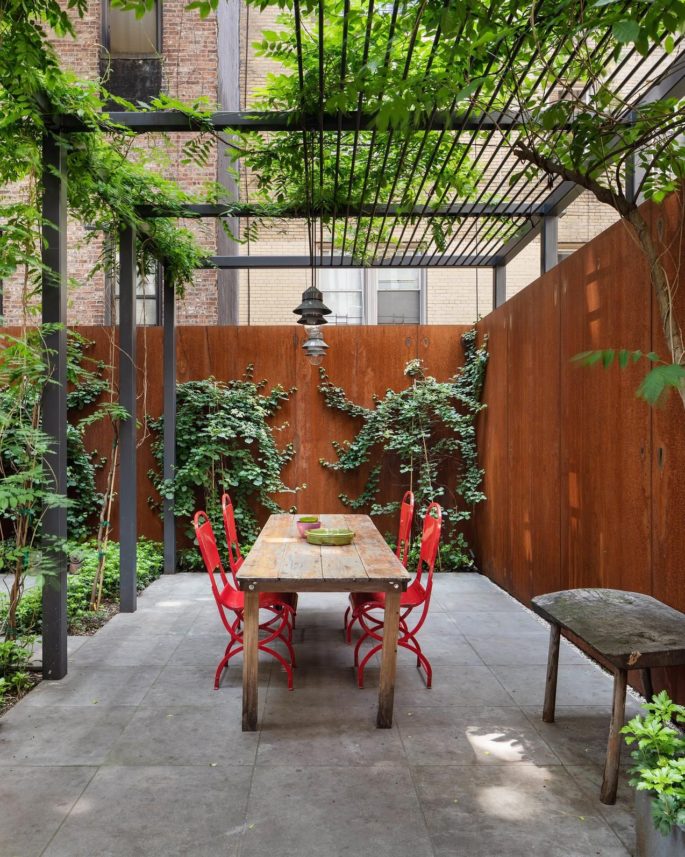Want to transform a so-so garden into a triumph? Turn it into additional living space. The biggest trends in landscape design have more to do with structures that connect inside and outside than with tending greenery.
A recent survey published in the Wall Street Journal revealed that the zeitgeist of garden design has little to do with botanical cultivation and everything to do with squeezing additional living space out of our outside areas. When the association asked 1,000 designers and contractors to predict the most influential landscaping trends for 2019, three emerged: pergolas, a framework or archway which delineates if not encloses an area; unpolished metal finishes, which lend an earthy elegance to structures like walls; and multitasking built-ins that make the most of the puny footprint many of us are working with. Design pros who’ve implemented these trends walk us through the tricked-out landscapes. Read more, ‘Your First Garden: How to Start a Garden for Practically Nothing.’
The integrated interior-exterior is very important.

Photograph by Bilyana Dimitrova courtesy of Pulltab Design
METAL FINISHES, HOLD THE SHINE
Where their predecessors favoured cedar and wrought iron, contemporary landscape architects are employing clean-lined expanses of unpolished metal—frequently opting for steel, preferable that oxidizes.
For a New York townhouse, whose owners wanted the garden to feel like part of their home, architect Devin O’Neill surrounded the backyard with walls of weathering steel, then added a black-painted steel trellis that supports a ceiling of exuberant wisteria vines. “The enclosure feels like another room,” says O’Neill, who founded Brooklyn’s O’Neill Rose Architects. The metal, the same material American sculptor Richard Serra uses for his monumental works, rusts within weeks, forming what O’Neill describes as a “beautiful brown leatherlike texture.” It’s also blissfully practical. “There’s not a lot you have to do to it over time,” he says. No power washing or refinishing. “It’s dummy-proof.” Corten steel’s availability in large sheets makes it a good choice for cladding. Landscape architects at Terremoto, in Los Angeles, wrapped a raised pool with corten, creating a brawny backdrop for a rambunctious surround of meadowy grasses. Other dark low-maintenance metals can also deliver toned-down luxury. For the street-facing front yard of Mr. O’Neill’s project on Manhattan’s Upper West Side, he opted for planters made of zinc, noting of the material, “It’s darker, and reflections are more subtle.” Read more, ’10 Garden Ideas to Steal from the Modernists.’

Pergolas create the feeling of a partially enclosed room. Photo via Grant & Power Landscaping.
SORT-OF SHELTERS
“A pergola helps create the feeling of a partially enclosed room, and guests usually feel most comfortable outdoors with some kind of protection,” says Scott Shrader, a Los Angeles exterior designer. He installs black-steel trellises with built-in hanging lights partly because metal requires less foundational footing than heavier options. Just be sure the structure echoes the architectural style of your home. A modern steel pergola will clash with a shingle-style house, noted New York landscape architect Edmund Hollander.
“The designs should be in the same language.”
In a front yard dotted with oak and walnut trees in St. Charles, Ill., landscape firm Grant & Power installed an Asian-inflected traditional example (above) that picked up on the Japanese flavour of the prairie-style house. Its built-in benches set above a flagstone patio make it a great spot to welcome guests and have a glass of wine. Read more, ‘Your Outdoor Furniture: 5 Mistakes to Avoid.’

Brooklyn architect Devin O’Neill enclosed a town house’s outdoor area with weathering steel, which requires almost zero maintenance. Photo via Michael Moran.
TWO-FACED FEATURES
Where space is at a premium, a garden’s man-made elements—known as the hardscape—must do double duty. In San Francisco’s Twin Peaks neighborhood, landscape architecture and urban design firm Surfacedesign installed a 16-foot retaining wall faced in limestone (above). It not only braces the hillside, it also incorporates a blackened steel fireplace and scattered LED-lit notches that double as footholds for climbing. Old-school hardscaping can also have dual functions. Mr. Hollander likes the ancient 2-for-1 of the Belgian fence—trees trained to entwine in a flat diamond-lattice pattern. “You’re espaliering fruit trees to create fences, but meanwhile you’re picking apples and pears,” he said. Original story taken from www.wsj.com


